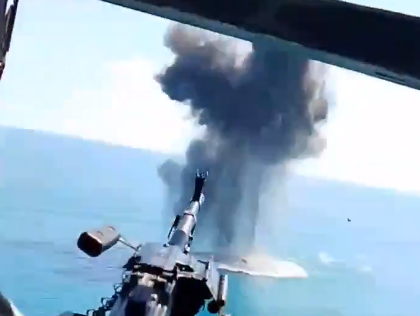WW3 here we come. Now that NATO has performed military drills all over the border with Russia, now Putin wants to play the same game.
Russia is sending four warships to Havana, Cuba, next week, a move perceived as an attempt to demonstrate that its navy remains a global power despite significant setbacks in the Black Sea. This deployment, which includes a nuclear-powered submarine, has been announced by Cuba’s Ministry of Foreign Affairs and is scheduled to occur between June 12 and 17. The Cuban government has stated that the visit, which involves ships not carrying nuclear missiles, is a part of the historically cordial relations between Russia and Cuba and does not pose a threat to the region.
However, according to a US official, this deployment is a strategic maneuver by Russia to flex its naval capabilities on the world stage. This comes in the wake of numerous losses the Russian navy has suffered in the Black Sea, where Ukraine claims to have destroyed a significant portion of Russia’s fleet. Ukraine’s forces have used drones, missiles, and other weaponry to damage many Russian warships, compelling Russia’s fleet to retreat to safer ports further away from Crimea. In March, the UK’s defense ministry declared Russia’s Black Sea Fleet “functionally inactive” after Ukraine claimed to have struck two additional Russian vessels. UK Defence Minister Grant Shapps remarked on Russia’s constrained naval activities, stating that despite Russia’s long history in the Black Sea since 1783, it is now forced to keep its fleet in port, where its ships remain vulnerable to attacks.
Russia to begin Air and Naval exercises in the Caribbean in the coming weeks as warships & aircrafts are heading to Cuba.
Cuban Missiles Crisis vibes. pic.twitter.com/E1td8ojyRQ
— MenchOsint (@MenchOsint) June 6, 2024
This week, reports indicated that Ukraine is continuing to target smaller Russian vessels using exploding naval drones, as Russia has pulled back its larger ships to reduce their vulnerability. Earlier this year, Russia also made changes to its naval leadership, reflecting ongoing challenges within its navy. The US official highlighted that while the US anticipates “heightened” Russian naval and air activity this summer and in the future, such deployments impose a financial burden on the Russian navy, which is already struggling with an aged fleet and maintaining operational readiness.
Despite the US official’s assertion that this deployment aims to demonstrate Russia’s continued global naval power, not everyone agrees on Russia’s motives. The Washington DC-based think tank, the Institute for the Study of War, suggested that this move could be an effort to evoke memories of the Cuban Missile Crisis, potentially aiming to dissuade the US from providing further support to Ukraine. This speculation aligns with recent threats from President Vladimir Putin to send long-range weapons to regions around the world that seek to target Western interests.
JUST IN: 🇷🇺 🇺🇸 Russia is sending warships for naval exercises near the USA in the Caribbean this summer, with port calls in Cuba (400 miles from the U.S) and Venezuela. pic.twitter.com/u5pCqb4u80
— Radar🚨 (@RadarHits) June 6, 2024
Meanwhile, Russia’s Ministry of Defence stated that the objective of the deployment is to maintain a Russian naval presence in strategically important areas of the “far ocean zone.” This statement, reported by RBC-Russia, indicates a broader goal of sustaining operational capabilities in key maritime regions.
The Deep State and NATO do seem intent on getting into a major conflict with Russia. Let’s all hope November gets here faster so we can elect Trump and give peace a chance.
Key Points:
i. Russia is sending four warships, including a nuclear-powered submarine, to Havana, Cuba, as announced by Cuba’s Ministry of Foreign Affairs.
ii. A US official claims this deployment aims to demonstrate Russia’s continued global naval power after significant losses to Ukraine in the Black Sea.
iii. Russia’s Black Sea Fleet has faced considerable setbacks, with Ukraine reportedly destroying a third of it using drones, missiles, and other weaponry.
iv. The deployment to Cuba is seen by some as a tactic to evoke memories of the Cuban Missile Crisis and potentially deter US support for Ukraine.
v. Despite the show of force, the Russian navy faces challenges in maintaining readiness and conducting deployments with its aging fleet.
RM Tomi – Reprinted with permission of Whatfinger News


